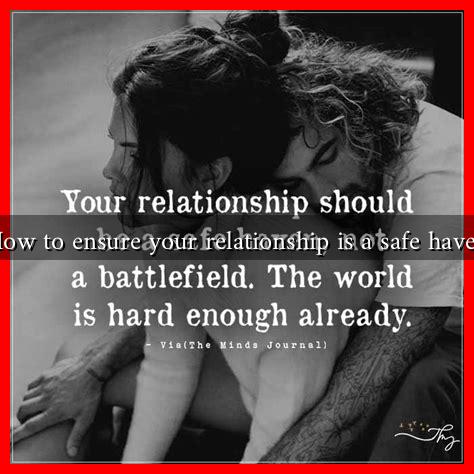-
Table of Contents
- How to Ensure Your Relationship is a Safe Haven
- Understanding the Concept of a Safe Haven
- Key Elements of a Safe Haven Relationship
- Strategies to Foster a Safe Haven
- 1. Prioritize Open Communication
- 2. Cultivate Emotional Intelligence
- 3. Establish Trust Through Consistency
- 4. Create a Safe Space for Vulnerability
- 5. Practice Conflict Resolution
- Real-Life Examples and Case Studies
- Conclusion
How to Ensure Your Relationship is a Safe Haven
In a world filled with stressors and uncertainties, having a relationship that serves as a safe haven can be a source of immense comfort and stability. A safe haven relationship is one where both partners feel secure, valued, and understood. This article explores practical strategies to cultivate such a relationship, ensuring that it remains a sanctuary amidst life’s challenges.
Understanding the Concept of a Safe Haven
A safe haven relationship is characterized by emotional safety, trust, and mutual respect. According to a study published in the Journal of Personality and Social Psychology, couples who perceive their relationship as a secure base are more likely to engage in open communication and exhibit higher levels of satisfaction. This concept is rooted in attachment theory, which suggests that secure attachments in relationships lead to healthier emotional outcomes.
Key Elements of a Safe Haven Relationship
To create a safe haven, several key elements must be present in your relationship:
- Open Communication: Honest dialogue fosters trust and understanding.
- Emotional Support: Being there for each other during tough times strengthens bonds.
- Respect for Boundaries: Recognizing and honoring each other’s personal space is crucial.
- Conflict Resolution Skills: Knowing how to navigate disagreements constructively is essential.
- Shared Values and Goals: Aligning on core beliefs and future aspirations enhances connection.
Strategies to Foster a Safe Haven
Here are some actionable strategies to ensure your relationship remains a safe haven:
1. Prioritize Open Communication
Effective communication is the cornerstone of any healthy relationship. Make it a habit to check in with each other regularly. Use “I” statements to express feelings without placing blame. For example, instead of saying, “You never listen to me,” try, “I feel unheard when we discuss important topics.” This approach encourages dialogue rather than defensiveness.
2. Cultivate Emotional Intelligence
Emotional intelligence involves recognizing and managing your own emotions while empathizing with your partner’s feelings. According to a study by the American Psychological Association, couples with high emotional intelligence report greater relationship satisfaction. Practice active listening and validate your partner’s feelings to enhance emotional connection.
3. Establish Trust Through Consistency
Trust is built over time through consistent actions. Be reliable and follow through on promises. If you say you will be there for your partner, make it a priority. Trust can also be reinforced by being transparent about your feelings and experiences.
4. Create a Safe Space for Vulnerability
Encourage each other to share fears, dreams, and insecurities without fear of judgment. Vulnerability fosters intimacy and strengthens the emotional bond. For instance, set aside time for deep conversations where both partners can express their thoughts freely.
5. Practice Conflict Resolution
Disagreements are inevitable in any relationship. However, how you handle conflict can either strengthen or weaken your bond. Use techniques such as:
- Taking a timeout if emotions run high.
- Focusing on the issue at hand rather than personal attacks.
- Seeking compromise and understanding each other’s perspectives.
Real-Life Examples and Case Studies
Consider the case of Sarah and John, a couple who struggled with communication. After attending a couples’ workshop, they learned to express their feelings openly and practice active listening. Over time, their relationship transformed into a safe haven where both felt valued and understood. Their story illustrates the power of commitment to improving communication skills.
Another example is the research conducted by Dr. John Gottman, a renowned relationship expert, who found that couples who engage in regular “state of the union” meetings—where they discuss their relationship’s strengths and areas for improvement—report higher satisfaction levels. This practice reinforces the idea that proactive communication is vital for maintaining a safe haven.
Conclusion
Creating a relationship that serves as a safe haven requires intentional effort and commitment from both partners. By prioritizing open communication, cultivating emotional intelligence, establishing trust, creating a safe space for vulnerability, and practicing effective conflict resolution, couples can build a strong foundation for a fulfilling relationship. Remember, a safe haven is not just a destination but an ongoing journey that evolves with time. Embrace the process, and you will find that your relationship can be a source of comfort and strength amidst life’s challenges.
For further reading on building healthy relationships, consider exploring resources from the Gottman Institute.




